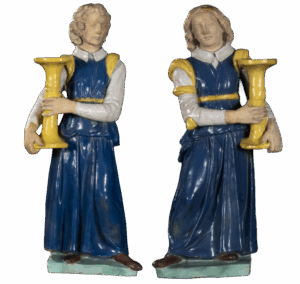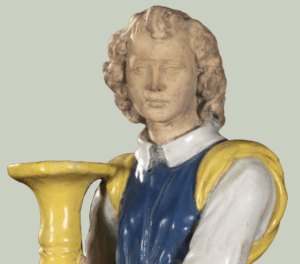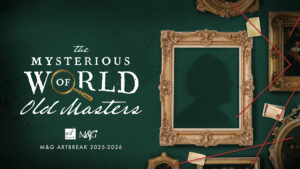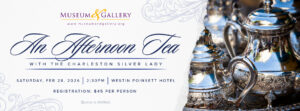St. Gabriel the Archangel
Unknown Pre-Raphaelite, 19th century
Below the image, click play to listen.
Glazed terracotta, c. 1500
Florence, 1459/60 – 1521
 Italian Renaissance masters like Donatello, Cellini, and Michaelangelo created magnificent sculptures chiseled from stone, carved from wood, or cast in metal. These methods were time-consuming and costly. In the early 1440s, Luca della Robbia, a stone sculptor in Florence, was able to cut the time and cost of sculpture production by developing techniques for tin-glazed terracotta. In addition to achieving the magnificent detail found in the expensive materials, he produced vibrant, permanent colors in his sculptures which other media could not duplicate. Also, he designed multiple modified pieces from molds, which greatly reduced production time and cost.
Italian Renaissance masters like Donatello, Cellini, and Michaelangelo created magnificent sculptures chiseled from stone, carved from wood, or cast in metal. These methods were time-consuming and costly. In the early 1440s, Luca della Robbia, a stone sculptor in Florence, was able to cut the time and cost of sculpture production by developing techniques for tin-glazed terracotta. In addition to achieving the magnificent detail found in the expensive materials, he produced vibrant, permanent colors in his sculptures which other media could not duplicate. Also, he designed multiple modified pieces from molds, which greatly reduced production time and cost.
As a businessman, Luca della Robbia managed a large workshop, where he produced high quality, tin-glazed terracotta pieces and preserved the secrecy of his formulas and techniques. His nephew, Andrea della Robbia inherited both Luca’s workshop and secrets. He became an outstanding sculptor, creating pieces beyond his uncle’s capabilities. (Andrea’s sons, Giovanni and Girolamo, also became sculptors and practiced the family’s secrets. Girolamo accepted the king of France’s invitation to Paris in 1517, where he made M&G’s terracotta busts of French nobility.)
The son of a sculptor, Benedetto Buglioni was born in Florence in 1459/60. He probably studied under Andrea del Verrocchio (Leonardo da Vinci’s teacher) and learned terracotta sculpting as a pupil in the della Robbia workshop of Luca and later Andrea. According to Giorgio Vasari, a contemporary artist and historian, Benedetto learned the “secret of glazed earthenware” from a female servant “who came out of the house of Andrea della Robbia.”
In his early 20s, Benedetto opened his own terracotta workshop in Florence. For unknown reasons, from 1487 to 1490, he and his brother produced terracotta works in Perugia, a city about 100 miles from Florence. Returning to Florence, the Buglioni brothers opened their own workshop and became della Robbia’s chief competitors. High quality, tin-glazed terracotta was extremely popular, and there were plenty of commissions for both workshops.
In time Benedetto was recognized as a master artist. His clients included major churches, important civic groups, and wealthy patrons, including the Medici family. His standing in the artistic community is recognized by the fact that he served on the committee which determined the placement of Michelangelo’s monumental David.
The Eucharist or Communion is a Christian sacrament instituted by Jesus Christ at the final supper before His crucifixion. He shared bread and wine with His disciples and told them the bread represented His body and the wine, His blood. His followers were to partake of the bread and wine as a reminder of His sacrifice and its eternal significance.
In Roman Catholic churches, the elements of the Eucharist are kept in a tabernacle, a locked and decorative box, built into the wall or placed on the altar. As part of the Catholic Mass, candles on either side of the tabernacle are lit. Traditionally, the candles are reminders that Christ is the light of the world and the church.
M&G’s angels probably held candles on either side of a tabernacle. These angels may have been part of a matching tabernacle and angel set, or they may have been used with a tabernacle made of other materials. There are few Renaissance terracotta tabernacles still in existence, and very few of those still have their original angel candlesticks. Of the existing Renaissance terracotta angel candlesticks, most lack tabernacles and some even lack their partner angel.
M&G’s terracotta candlesticks are a typical height—roughly 22 inches; however, their design details vary greatly. Some Renaissance angel candlesticks stand, others kneel. Some wear robes, stoles, surpluses, sashes, jewelry, or belts; others have intricate collars, cuffs or hems. Some are barefoot, some wear sandals, and others wear shoes. Many have wings, and some, like M&G’s, were designed wingless.
M&G’s Pair of Angels with Candlesticks began as a piece of wood wrapped in wet cloths. A molded clay body was formed around the cloths. The body then received a head, arms, hands, feet, clothing details, and candle holder. Some of these additions were based on standard clay molds, and others were hand-sculpted from raw clay. When the sculpture was complete and the clay set, the wood and cloths were removed, leaving a hollow center, necessary for proper drying and firing.
 The head and hands of M&G’s angels are not glazed; these areas are the color of baked clay. A tin oxide glaze was painted over all the areas to be glazed and then fired, leaving a beautiful white as seen in the angels’ collars and sleeves. Next, a blue cobalt and a yellow lead glaze were painted over the white. When fired again, the glazes fused with the terracotta, became enameled, and their colors permanent.
The head and hands of M&G’s angels are not glazed; these areas are the color of baked clay. A tin oxide glaze was painted over all the areas to be glazed and then fired, leaving a beautiful white as seen in the angels’ collars and sleeves. Next, a blue cobalt and a yellow lead glaze were painted over the white. When fired again, the glazes fused with the terracotta, became enameled, and their colors permanent.
Renaissance sculptors rarely signed their works. If found, contracts and payment records can establish who created larger objects; however, smaller works are most often associated with a particular workshop based on style, quality, and the figure’s individual details. Experts agree that M&G’s angels can be attributed to Benedetto Buglioni and his workshop.
Although these angels no longer serve during church services, they do speak to us of the craftmanship of Renaissance tin-glazed terracotta masters. They may also cause us to think of those who saw them in the warm glow of their candles more than 500 years ago.
William Pinkston, retired educator and M&G volunteer
Suggested Reference
Della Robbia: Sculpting with Color in Renaissance Florence by Marietta Cambareri, with contributions by Abigall Hykin and Cortney Harris
Published 2025
In this lovely Adoration of the Shepherds we see one of the worshipers playing a musical instrument–an instrument used for village celebrations during the painter’s lifetime.
Search the details in a handful of Christmas-themed M&G paintings, which are currently out on loan to other museums. This listening and looking scavenger hunt is for “merry” observers of ALL ages!
Click HERE to begin.
The Christmas season is rich in the beauty of sights and sounds! Referencing selections from M&G’s masterworks and timeless carols, observers of all ages will not only discover exciting details in each painting, but also learn about some of the biblical and art history connections.
Click HERE to begin.
Enjoy this focused selection of short video clips and audio stops featuring M&G paintings depicting elements of the Biblical Christmas story.

Whether you like delving into forensic evidence or prefer observing the patterns of human behavior these lectures are designed to awaken the sleuth in you. Referencing M&G’s collection, we’ll explore some of the “mysteries” of the art world—from the creative to the criminal.
Presented by M&G members, Glenn and Joyce Bridges and with additional support from M&G members, Scott and Kathy Hoster.
Dates: 3rd Tuesdays at Noon, during academic year
Location: The Davis Room, Dixon-McKenzie Dining Common on the campus of Bob Jones University
Parking: reserved spaces will be available in M&G’s parking lot.
Note: AVI Fresh Catering will provide a Deli Bar with the following spread: sliced oven-roasted turkey, roasted beef, and ham, and tuna; a cheese and relish tray; a variety of baked breads and rolls, two green salads, chips, assorted cookies, and beverages.
Cost:
Registration: Click on the dates below to register.
What is an Old Master? What makes a painting valuable? Who is the artist? Christopher Apostle, International Head of Old Masters at Sotheby’s, will begin our exploration with examples and stories laying the foundation for uncovering clues that unlock some of these “mysteries.”
Prior to the 15th century, artists were primarily viewed as anonymous craftsmen, but with the dawn of the Renaissance their role and influence began to change. Artists became more diligent in signing their work, and now hundreds of years later we can easily identify the painter of a masterpiece—or can we? This week John Nolan will look at the treasure trove of clues that may be found on the front (recto) and back (verso) of a painting—clues that can help us discern differences among original variations, legitimate copies, and studio versions of “a masterpiece.”
Connoisseurship can play a vital role not only in the authentication of a masterwork but also in the rediscovery of a great master. This week, M&G Director of Education Donnalynn Hess and M&G Executive Director Erin Jones will look at how the obsession of one 19th-century collector led to the rediscovery of an “obscure Dutch painter” named Vermeer. We’ll also highlight some of the secrets related to “gems” in our M&G collection.
Conservation encompasses both the restoration and preservation of a collection. This week, conservator William P. Brown, a leader in the field of art preservation and an expert in the treatment of Old Master paintings, will share the artistic, creative, analytical, and problem-solving skills he uses in this fascinating “investigative” work.
Why do artists abandon a work in progress, paint over a previous image or alter their original composition? The reasons are sometime financial, artistic, political, or simply unknown. With a special focus on Florentine painter Andrea del Sarto, Dr. Nelda Damiano, the Pierre Daura Curator of European Art a the Georgia Museum of Art, will look at what has been uncovered about his artistic process and what remains a mystery.
Forgery is a process, not just of imitation, but of deception. It’s in the art of the con—the ability to manipulate others for personal and material gain. This week, M&G Director of Education Donnalynn Hess and Executive Director Erin Jones will zero in on several of the 20th-century’s most notorious forgers. We’ll also explore how the business of art serves not only to authenticate the legitimate value of a masterwork but also to unmask “the art of the con.”

Drinking hot tea has been around for centuries, but it was the English that made Afternoon Tea a tradition. Popular lore credits the pastime to Anna, Duchess of Bedford in 1840. Dawn Corley explains, “At this time in history, dinner was very late in the day and even later during the long months of summer. Quite often dinner would be served at 10:00 p.m. or commonly much later. Anna had the idea to have little cakes and tea brought to her in her boudoir.” The Duchess later invited friends to join her daily habit, and eventually, the social elite followed, transforming tea drinking into a social ritual through her invention.
Join M&G for an experience to savor an English tea as the Charleston Silver Lady, Dawn Corley shares fascinating insights about two of her lifetime interests: beautiful Victorian-era silver objects from her private collection and history’s most treasured adornment—unusual, natural pearls.
A portion of the proceeds will go toward M&G’s annual fund.
Register HERE.
Space is limited.
Guests will also enjoy an exclusive opportunity to purchase uncommon pearls from some of the world’s richest diving fields.
While this artist’s paintings are well represented in Spain, rarely is he found outside his native country. M&G’s Pentecost is considered the finest example of Juan de Juanes’ work in America.